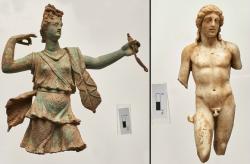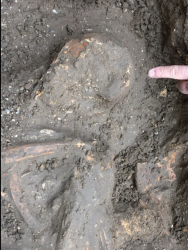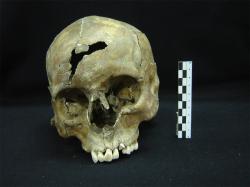INSTITUT SUPERIEUR D'ANTHROPOLOGIE
INSTITUTE OF ANTHROPOLOGY
ONLINE COURSES / COURS A DISTANCE
SPRING TERM : APRIL 2016
REGISTER NOW
GRECE –  Aptera - Archaeologists excavating a Roman-era villa in Crete have uncovered two impressive, small-sized statues depicting the gods Artemis and Apollo, according to a statement by the Greek Ministry of Culture. Found in the archaeological site of Aptera, a city in western Crete destroyed by an earthquake in the 7th century AD, the sculptures date to the first or second century AD and stand at around 21 inches in height. The one depicting the hunting goddess Artemis is made of copper, while the other, portraying her twin brother Apollo, is carved from marble. Once standing on an ornate base also made of copper, Artemis is wearing a short chiton, or tunic, and is ready to shoot an arrow. The statue is described as being in an excellent state of preservation. The marble statuette of Apollo is simpler in style, but nevertheless finely carved. Traces of red paint are still visible on the statue’s pedestal. According to the team led by archaeologist Vanna Niniou-Kindelis, director of excavations at Aptera, both sculptures were likely imported to the island in order to decorate a shrine in the luxury Roman villa in which they were found.
Aptera - Archaeologists excavating a Roman-era villa in Crete have uncovered two impressive, small-sized statues depicting the gods Artemis and Apollo, according to a statement by the Greek Ministry of Culture. Found in the archaeological site of Aptera, a city in western Crete destroyed by an earthquake in the 7th century AD, the sculptures date to the first or second century AD and stand at around 21 inches in height. The one depicting the hunting goddess Artemis is made of copper, while the other, portraying her twin brother Apollo, is carved from marble. Once standing on an ornate base also made of copper, Artemis is wearing a short chiton, or tunic, and is ready to shoot an arrow. The statue is described as being in an excellent state of preservation. The marble statuette of Apollo is simpler in style, but nevertheless finely carved. Traces of red paint are still visible on the statue’s pedestal. According to the team led by archaeologist Vanna Niniou-Kindelis, director of excavations at Aptera, both sculptures were likely imported to the island in order to decorate a shrine in the luxury Roman villa in which they were found.
http://news.discovery.com/history/archaeology/statues-of-greek-gods-unearthed-in-crete-160127.htm
USA –  St. Augustine - Historic burials have been discovered in St. Augustine, and they’re believed to be part of the first Catholic parish church in the United States. On Tuesday, they found a human skull protruding from the dirt just a few feet below the road. After cautiously brushing away the dirt for a few more hours, the archaeologists also found the jaw from another person and his spine and pelvis as well as a leg bone from another person. Skeletal remains from three different people have been found so far, according to City Archaeologist Carl Halbirt. There could be more. This was the site of Los Remedios. “It was in fact St. Augustine’s first parish church and cemetery,” Halbirt noted. It served the people of St. Augustine from late 1500’s to 1702. Halbirt explained that the “cemetery would have been just inside the walls of the church and just outside the walls of the church.”
St. Augustine - Historic burials have been discovered in St. Augustine, and they’re believed to be part of the first Catholic parish church in the United States. On Tuesday, they found a human skull protruding from the dirt just a few feet below the road. After cautiously brushing away the dirt for a few more hours, the archaeologists also found the jaw from another person and his spine and pelvis as well as a leg bone from another person. Skeletal remains from three different people have been found so far, according to City Archaeologist Carl Halbirt. There could be more. This was the site of Los Remedios. “It was in fact St. Augustine’s first parish church and cemetery,” Halbirt noted. It served the people of St. Augustine from late 1500’s to 1702. Halbirt explained that the “cemetery would have been just inside the walls of the church and just outside the walls of the church.”
VIDEO = http://www.firstcoastnews.com/news/local/st-augustine/historic-burials-found-in-archeaological-dig-in-st-augustine/23243615
Mexique -  Tenochtitlan - Who were the individuals sacrificed at the Great Temple of Tenochtitlan? Historical sources mention prisoners of war, but a recent study indicates that not all of them were taken from conquered lands and some were residents of the Valley of Mexico. "There was this general idea that sacrifices were mostly the result of wars, people taken from the populations gradually conquered" by the Mexicas, whose imperial capital was Mexico-Tenochtitlan, archaeologist Alan Barrera, who conducted the study, told EFE. It was also thought that victims "were brought directly from their places of origin and sacrificed almost immediately" after arriving in the metropolis, Barrera said. A study of human bone fragments, however, made it possible to conclude that some of the victims of sacrifices had been living among the Mexica for at least six years. Young men captured in wars were not the only people sacrificed, and the victims included women, the elderly and children. To reach these conclusions, the researchers took samples from the remains of six individuals found among the Great Temple's sacrificial victims, extracting the material from skulls and teeth. The samples were put through a strontium isotope analysis to identify the individuals' places of origin.The researchers operated on the premise that in ancient societies, it was not very feasible for individuals to travel from one region to the other, and that people mostly ate local products. Individuals marked for sacrifice but not among captured warriors became "captives to be servants for the elite," made up of people with some high political rank. The individuals whose remains were studied at the isotope geochemistry lab of the National Autonomous University of Mexico's Geophysics Institute lived between 1469 and 1521, during the reigns of Motecuhzoma Ilhuicamina, Axayacatl and Moctecuhzoma Xocoyotzin.
Tenochtitlan - Who were the individuals sacrificed at the Great Temple of Tenochtitlan? Historical sources mention prisoners of war, but a recent study indicates that not all of them were taken from conquered lands and some were residents of the Valley of Mexico. "There was this general idea that sacrifices were mostly the result of wars, people taken from the populations gradually conquered" by the Mexicas, whose imperial capital was Mexico-Tenochtitlan, archaeologist Alan Barrera, who conducted the study, told EFE. It was also thought that victims "were brought directly from their places of origin and sacrificed almost immediately" after arriving in the metropolis, Barrera said. A study of human bone fragments, however, made it possible to conclude that some of the victims of sacrifices had been living among the Mexica for at least six years. Young men captured in wars were not the only people sacrificed, and the victims included women, the elderly and children. To reach these conclusions, the researchers took samples from the remains of six individuals found among the Great Temple's sacrificial victims, extracting the material from skulls and teeth. The samples were put through a strontium isotope analysis to identify the individuals' places of origin.The researchers operated on the premise that in ancient societies, it was not very feasible for individuals to travel from one region to the other, and that people mostly ate local products. Individuals marked for sacrifice but not among captured warriors became "captives to be servants for the elite," made up of people with some high political rank. The individuals whose remains were studied at the isotope geochemistry lab of the National Autonomous University of Mexico's Geophysics Institute lived between 1469 and 1521, during the reigns of Motecuhzoma Ilhuicamina, Axayacatl and Moctecuhzoma Xocoyotzin.
http://latino.foxnews.com/latino/entertainment/2016/01/25/study-overturns-prevailing-ideas-about-sacrifices-at-tenochtitlan/